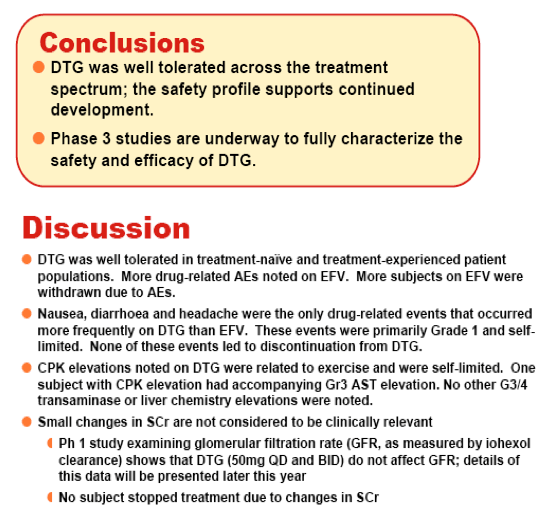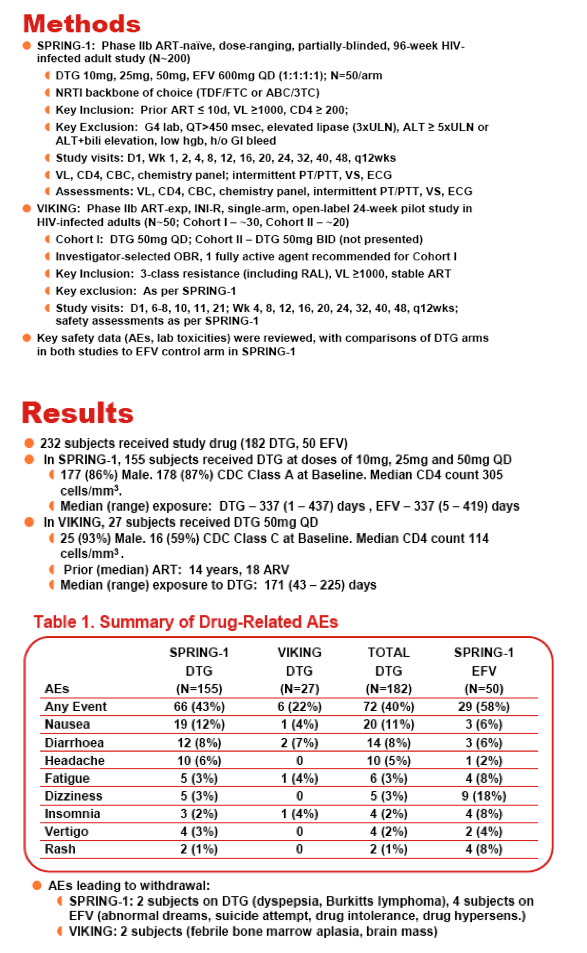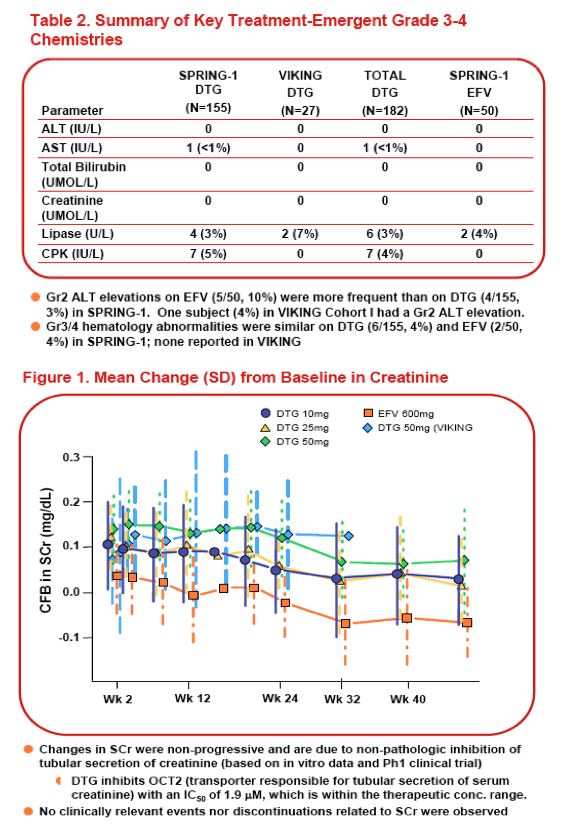 |
 |
 |
| |
Safety Profile of Dolutegravir (DTG, S/GSK1349572), a Next Generation Integrase Inhibitor (INI) in Combination Therapy in Antiretroviral (ART)-naïve and ART-experienced
Adults from Phase 2b Studies
|
| |
| |
Reported by Jules Levin
6th IAS Conference on HIV Pathogenesis, Treatment & Prevention, Rome, Italy July 17th - July 20th
S Min1, A Carrod2, L Curtis2, C Stainsby2, C Brothers1, J Yeo2, G Nichols1
1GSK RTP, NC, USA; 2GSK Stockley Park, UK
IAS: ViiV 'Next Generation' Integrase Dolutegravir, 48 Weeks SPRING-1 Study Naives - (07/21/11)

Background: DTG has demonstrated potent, sustained antiviral activity with once daily, unboosted dosing in ART-naïve and -experienced adults. The safety profile in the Phase IIb development program was examined.
Methods: 48 week data from a multicentre, partially-blinded Phase IIb study
(SPRING-1) in therapy-naïve adults receiving 10mg, 25mg or 50mg DTG or efavirenz (EFV) 600mg once daily (QD) and 24 week data from a multicentre, single arm Phase IIb pilot study (VIKING) in raltegravir-resistant, therapy-experienced adults receiving 50mg DTG QD were analyzed.
Results:
232 subjects received study drug (182 DTG; 50 EFV). The most frequent drug-related AEs observed on DTG were nausea (11%), diarrhea (8%) and headache (5%).
Dizziness (18%), fatigue, insomnia and rash (8% each) were common with EFV. Few withdrawals due to AEs occurred in subjects receiving DTG: two subjects in SPRING-1 due to dyspepsia (related, 25mg) and BurkittŐs lymphoma (unrelated, 50mg) and two subjects in VIKING (50mg QD) due to brain mass (unrelated) and febrile bone marrow aplasia (unrelated).
Few SAEs were reported in subjects receiving DTG; none were considered related to DTG. In subjects receiving DTG, small mean increases in creatinine (6.4-11.9μmol/L) were noted at Week 1, remained stable to Week 20 and then decreased out to Week 48. In vitro data show DTG causes a benign inhibition of creatinine secretion.
Treatment-emergent G3/4 hematologic toxicities were infrequent on DTG (4%) and EFV (4%) in SPRING-1, with none in VIKING.
Treatment-emergent Grade 3/4 liver chemistry elevations were uncommon: one subject (DTG 10 mg) in SPRING-1 had exercise-related, transient, asymptomatic G3 AST and G4 CPK. In SPRING-1, Grade 2-4 ALT elevations were more common on EFV (5/50, 10%) than DTG (4/155, 3%).
Conclusion: DTG was well tolerated across the treatment spectrum; its safety profile supports continued development. Phase 3 studies are underway.
Introduction
Dolutegravir is the only once daily INI that does not require a PK booster
SPRING-1 (2 NRTIs plus DTG vs. EFV in treatment-naïve, HIV-infected adults)
demonstrated excellent treatment responses through 48wks (proportion <50c/mL: 88-91% across DTG arms vs. 82% on EFV)1
VIKING (Cohort I, DTG 50mg QD in raltegravir-resistant, HIV-infected adults)
demonstrated activity of DTG in this patient population (proportion of subjects
with OBT PSS > 1 and <50 c/mL through 24wks was 67%)2
A combined safety analysis of these two studies was conducted


References
1. Van Lunzen J et al. Rapid, robust and sustained antiviral response with once-daily (QD) dolutegravir (DTG, S/GSK1349572), a next generation integrase inhibitor (INI) in combination therapy in antiretroviral-naïve adults: 48 week results from SPRING-1 (ING112276). IAS 2011. Rome, Italy. 17-20
Jul, 2011. Abstract TUAB0102.
2. Eron J et al. Activity of the integrase inhibitor S/GSK1345972 in subjects with HIV exhibiting raltegravir resistance: week 24 results of the VIKING study (ING112961). 10th Int Congress on Drug Therapy in HIV Infection, 7-11 Nov 2010, Glasgow, UK. J IAS 2010,13 (suppl4):051.
|
| |
|
 |
 |
|
|